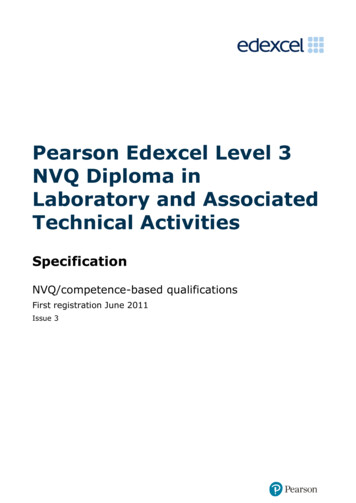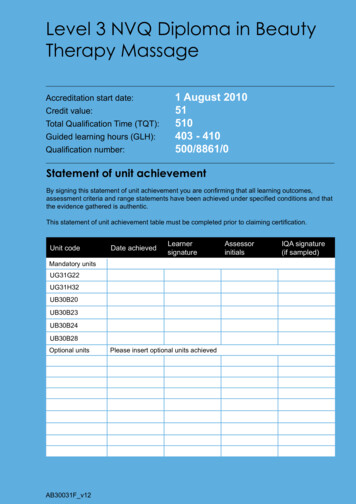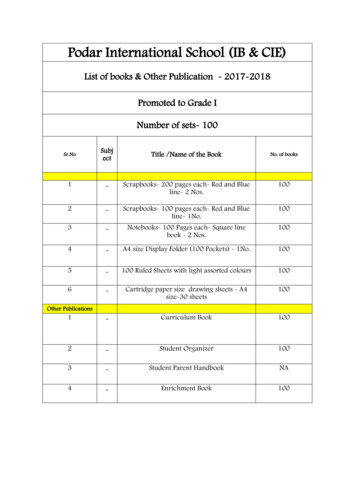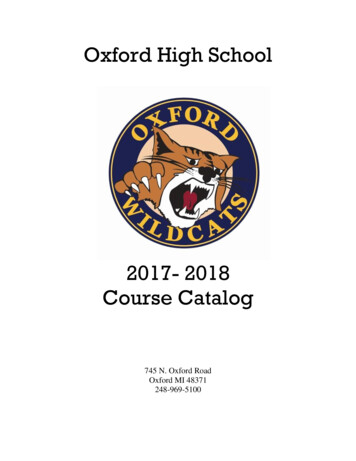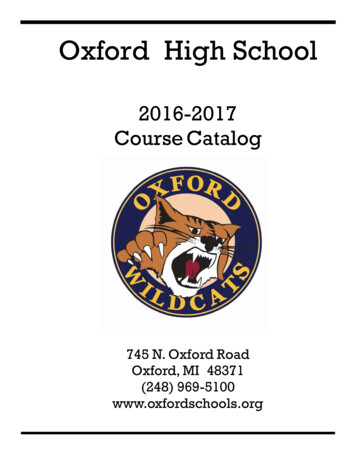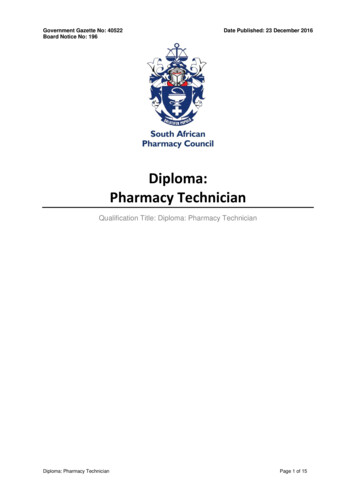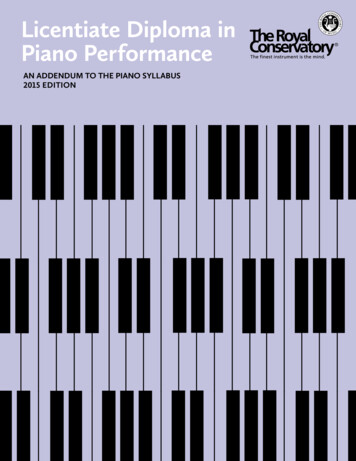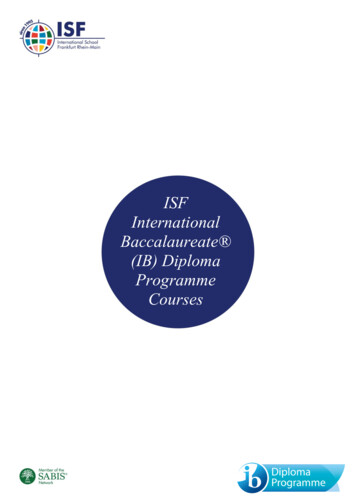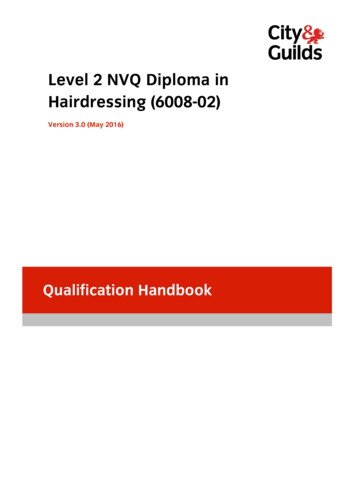
Transcription
Level 2 NVQ Diploma inHairdressing (6008-02)Version 3.0 (May 2016)Qualification Handbook
Qualification at a glanceSubject areaHairdressingCity & Guilds number6008Age group approved16-19, 19 Entry requirementsAssessment typesApprovalsSupport materialsNonePortfolio; Multiple Choice; Short AnswerApproval application required; Fast track approvalAssessor Guide; Question papers and Mark schemes;Candidate logbook; Qualification textbookApprenticeshipThe qualification is included in:- Intermediate Level Apprenticeship in HairdressingRegistration and certificationConsult the Walled Garden/Online Catalogue for lastdatesTitle and levelCity & GuildsnumberAccreditation numberLevel 2 NVQ Diploma in Hairdressing6008-02601/5696/XLevel 2 NVQ Diploma in Hairdressing (6008-02)2
Version and dateChange detailSection1.1 July 2015Unit 208 - Corrected statement to read “2 outof the 3 areas listed in the range" rather than“3 out of the 4".Unit 212 - added knowledge statement K21 toAC3.2Unit 214 - added range for "neckline shapes","factors" and "outline shapes".Values and Behaviours updatedCorrected definitions for “3D” and“Disinfection” in Appendix 3Units, Appendix 1, 2, 31.2 October 2015Added text to the evidence requirements forunit 209 (CH5)Units2.0 November 2015Clarification made to requirements for staffdelivering the qualification.Centre Requirements3.0 May 2016Unit evidence requirements updated in linewith revised habia assessment strategyUnitsLevel 2 NVQ Diploma in Hairdressing (6008-02)3
ContentsQualification at a glance2Contents41Introduction62Structure73Centre Requirements8ApprovalResource requirementsLearner entry requirements4Delivering the qualificationInitial assessment and inductionSupport materials5AssessmentSummary of assessment methodsAssessment typesAssessment strategyRecognition of Prior Learning (RPL)6Units889101010111111131415UnitsUnit numbering1515Unit 201Style and finish hair (CH1)16Unit 202Set and dress hair (CH2)24Unit 203Cut hair using basic techniques (CH3)32Unit 204Colour and lighten hair (CH4)38Unit 205Advise and consult with clients (CHB9)47Unit 206Shampoo, condition and treat the hair and scalp (CHB11)53Unit 207Develop and maintain your effectiveness at work (CHB12)60Unit 208Relax hair (AH2)64Unit 209Perm and neutralise hair (CH5)73Unit 210Plait and twist hair (CH6)82Unit 211Temporarily attach hair to enhance a style (CH7)89Unit 212Remove hair extensions (CHB8)97Unit 213Fulfil salon reception duties (CHB13)Level 2 NVQ Diploma in Hairdressing (6008-02)1024
Unit 214Cut men's hair using basic techniques (CB2)107Appendix 1Values115Appendix 2Behaviours116Appendix 3Glossary117Appendix 4Useful contacts124Dummy Front Matter Cha pter Title - please do not include in out putLevel 2 NVQ Diploma in Hairdressing (6008-02)5
1IntroductionAreaDescriptionWho is the qualification for?The Level 2 NVQ Diploma in Hairdressing isdesigned for learners who work in or wish topursue a career in hairdressing.The Level 2 NVQ Diploma in Hairdressingprovides the necessary skills and knowledgethat prove occupational competence as a juniorstylist.What does the qualification cover?This qualification allows candidates to learn,develop and practice the skills required toprovide hairdressing services for all hair types.The Level 2 NVQ Diploma in Hairdressing coversa range of skills and knowledge such as cutting,drying, styling, colouring and lightening, relaxingand perming as well as shampooing andconsulting with clients.What opportunities for progression are there?Learners may progress to employment and/or tothe following City & Guilds qualification:Level 3 NVQ Diploma in HairdressingLevel 3 NVQ Diploma in BarberingWho did we develop this qualification with?This qualification has been developed withHabia.Are they part of an apprenticeship frameworkor initiative?This qualification can form part of the followingapprenticeship:Intermediate Level Apprenticeship inHairdressingLevel 2 NVQ Diploma in Hairdressing (6008-02)6
2StructureTo achieve the City & Guilds Level 2 NVQ Diploma in Hairdressing, learners must achieve aminimum of 64 credits overall. 55 credits must be achieved from the mandatory units, and aminimum of 9 credits must be achieved from the optional units.UANCity & Guildsunit numberUnit titleCredit valueGLHJ/506/9372201Style and finish hair658L/506/9373202Set and dress hair762D/506/9782203Cut hair using basictechniques12111K/506/9381204Colour and lighten hair14124F/506/9368205Advise and consult withclients863T/506/9383206Shampoo, condition andtreat the hair and scalp540L/506/9499207Develop and maintainyour effectiveness atwork326R/506/9360208Relax hair982M/506/9382209Perm and neutralise hair1093R/506/9374210Plait and twist hair542M/506/9494211Temporarily attach hairto enhance a style330Y/506/9375212Remove hair extensions548R/506/9584213Fulfil salon receptionduties647J/506/9775214Cut men's hair usingbasic techniques12111MandatoryOptionalLevel 2 NVQ Diploma in Hairdressing (6008-02)7
3Centre RequirementsApprovalIf your Centre is approved to offer the qualification 3008-02/3008-52/3008-82 Level 2 NVQ Diplomain Hairdressing you can apply for the new 6008-02/6008-92 Level 2 Diploma in Hairdressing approvalusing the fast track approval form, available from the City & Guilds website.Centres should use the fast track form if: there have been no changes to the way the qualifications are delivered, and they meet all of the approval criteria in the fast track form guidance notes.Fast track approval is available for 12 months from the launch of the qualification. After 12 months,the Centre will have to go through the standard Qualification Approval Process. The centre isresponsible for checking that fast track approval is still current at the time of application.To offer this qualification, new centres will need to gain both centre and qualification approval.Please refer to the City & Guilds Centre Manual for further information.Centre staff should familiarise themselves with the structure, content and assessment requirementsof the qualification before designing a course programme.Resource requirementsCentre staffingStaff delivering this qualification must be able to demonstrate that they meet the followingoccupational expertise requirements. They should: be occupationally competent and/or technically knowledgeable in the area(s) for which they aredelivering training and/or have experience of providing training. This occupational competenceor knowledge must be at least one level above the training being delivered have recent relevant experience in the specific area they will be assessing have credible experience of providing trainingThe assessor must: hold, or be working towards a valid assessors' qualification based on LSIS, formally LLCC,Learning and Development National Occupational Standards (2010) have an in-depth technical knowledge of the qualification complete a minimum of 30 CPD hours per annum (1 Sep-31 Aug).Centre staff may undertake more than one role, eg tutor and assessor or internal quality assurer,but cannot internally quality assure their own assessments.Please refer to the Assessor Guide document for details on the role of the supervisors andmanagers as witnesses.Level 2 NVQ Diploma in Hairdressing (6008-02)8
Learner entry requirementsCity & Guilds does not set entry requirements for these qualifications. However, centres mustensure that candidates have the potential and opportunity to gain the qualifications successfully.Age restrictionsThe Level 2 NVQ Diploma in Hairdressing is not approved for use by candidates under the age of 16,and City & Guilds cannot accept any registrations for candidates in this age group.Centres and candidates should be fully aware of minimum age requirements and any implicationson completing assessments.Level 2 NVQ Diploma in Hairdressing (6008-02)9
4Delivering the qualificationInitial assessment and inductionAn initial assessment of each candidate should be made before the start of their programme toidentify: if the candidate has any specific training needs support and guidance they may need when working towards their qualifications any units they have already completed, or credit they have accumulated which is relevant to thequalifications the appropriate type and level of qualification. If the candidate understands the people involved in the assessment and how to evidence theirperformance at work and compile a portfolio of evidenceWe recommend that centres provide an induction programme so the candidate fully understandsthe requirements of the qualifications, their responsibilities as a candidate, and the responsibilitiesof the centre. This information can be recorded on a learning contract.Support materialsThe following resources are available for these qualifications:DescriptionHow to accessQuestion papers and markschemewww.cityandguilds.comQualification textbookCan be ordered from Walled Garden,viawww.cityandguildsbookshop.comor from your Business ManagerAssessor guidewww.cityandguilds.comCandidate logbookwww.cityandguilds.comRecording documentsCandidates and centres may decide to use a paper-based or electronic method of recordingevidence. City & Guilds premium logbooks can be ordered from the Walled Garden(www.walledgarden.com).City & Guilds endorses several ePortfolio systems, including our own, Learning Assistant, an easyto-use and secure online tool to support and evidence learners’ progress towards achievingqualifications. Further details are available at: www.cityandguilds.com/eportfolios.Level 2 NVQ Diploma in Hairdressing (6008-02)10
5AssessmentSummary of assessment methodsCandidates must: have a completed portfolio of evidence for each unit have achieved/completed the essential knowledge and understanding requirementsAssessment typesUnitTitleAssessment methodWhere to obtainassessmentmaterialsCross unit knowledgeOnline test OR shortanswer question testOnline testnumber 690Short answerpapers andmarking guidesavailable on City& Guilds website201Style and finish hairPortfolioandOnline test OR shortanswer question testOnline testnumber 601Short answerpapers andmarking guidesavailable on City& Guilds website202Set and dress hairPortfolioandOnline test OR shortanswer question testOnline testnumber 602Short answerpapers andmarking guidesavailable on City& Guilds website203Cut hair using basic techniquesPortfolioandOnline test OR shortanswer question testOnline testnumber 603Short answerpapers andmarking guidesavailable on City& Guilds website204Colour and lighten hairPortfolioandOnline test OR shortanswer question testOnline testnumber 604Short answerpapers andLevel 2 NVQ Diploma in Hairdressing (6008-02)11
UnitTitleAssessment methodWhere to obtainassessmentmaterialsmarking guidesavailable on City& Guilds website205Advise and consult with clientsPortfolioandOnline test OR shortanswer question testOnline testnumber 605Short answerpapers andmarking guidesavailable on City& Guilds website206Shampoo, condition and treat the hairand scalpPortfolioandOnline test OR shortanswer question testOnline testnumber 606Short answerpapers andmarking guidesavailable on City& Guilds website207Develop and maintain your effectivenessat workPortfolioandOnline test OR shortanswer question testOnline testnumber 607Short answerpapers andmarking guidesavailable on City& Guilds website208Relax hairPortfolioandOnline test OR shortanswer question testOnline testnumber 608Short answerpapers andmarking guidesavailable on City& Guilds website209Perm and neutralise hairPortfolioandOnline test OR shortanswer question testOnline testnumber 609Short answerpapers andmarking guidesavailable on City& Guilds website210Plait and twist hairPortfolioandOnline test OR shortanswer question testOnline testnumber 610Short answerpapers andmarking guidesavailable on City& Guilds website211Temporarily attach hair to enhance astylePortfolioandOnline testnumber 611Short answerLevel 2 NVQ Diploma in Hairdressing (6008-02)12
UnitTitleAssessment methodWhere to obtainassessmentmaterialsOnline test OR shortanswer question testpapers andmarking guidesavailable on City& Guilds website212Remove hair extensionsPortfolioandOnline test OR shortanswer question testOnline testnumber 612Short answerpapers andmarking guidesavailable on City& Guilds website213Fulfil salon reception dutiesPortfolioandOnline test OR shortanswer question testOnline testnumber 613Short answerpapers andmarking guidesavailable on City& Guilds website214Cut men's hair using basic techniquesPortfolioandOnline test OR shortanswer question testOnline testnumber 614Short answerpapers andmarking guidesavailable on City& Guilds websiteAssessment strategyThe assessment strategy for this qualification has been produced in partnership with industry,awarding organisations and Habia.It outlines the principles and requirements to be applied to assessment of performance andcompetence, and knowledge and understanding for this qualification. All of the information fromthe strategy can be found in the Qualification Handbook and the Assessor Guide documents, inaddition a full copy of the strategy can be downloaded from the Habia website.The strategy specifies the evidence requirements for each unit. These are included in thesupporting evidence section of each unit in the handbook.The strategy specifies that candidates must sit externally set questions for the following units:City & GuildsUnit NumberNOSReferenceLevelUnit Titlen/a2Cross unit knowledge testLevel 2 NVQDiploma inHairdressing690Level 2 NVQ Diploma in Hairdressing (6008-02)13
City & GuildsUnit NumberNOSReferenceLevelUnit Title204CH42Colour and lighten hair205CHB92Advise and consult with clients206CHB112Shampoo, condition and treat the hair and scalp208AH22Relax hair209CH52Perm and neutralise hairCity & Guilds has also produced assessments for all the remaining units.For more information on how this qualification is assessed, please refer to the Assessor Guidedocument.Recognition of Prior Learning (RPL)Recognition of Prior Learning (RPL) is an assessment process which makes use of evidence of alearner’s previous non-certificated achievements to demonstrate competence or achievementwithin a unit or qualification. RPL allows an individual to avoid unnecessary learning, meaning thatthey can present for summative assessment without repeating learning in areas where they will beable to show that they can meet the learning outcome(s).It remains the role of assessors and quality assurance staff to ensure that evidence for RPL meetsthe relevant outcomes of the qualification.The centre manual contains further information on RPL.Level 2 NVQ Diploma in Hairdressing (6008-02)14
6UnitsUnitsThe qualifications comprise of a number of units. A unit describes what is expected of a competentperson in particular aspects of his/her job.Each unit is divided into learning outcomes which describe in further detail the skills andknowledge that a candidate should possess.Each learning outcome has a set of assessment criteria (performance, and knowledge andunderstanding) which specify the desired criteria that have to be satisfied before an individual canbe said to have performed to the agreed standard. The practical and knowledge requirementsfrom the National Occupational Standards are mapped to each assessment criteria.Range statements define the breadth or scope of a learning outcome and its assessment criteria bysetting out the various circumstances in which they are to be applied. There are two types of range:practical and knowledge. Practical range is specific to learning outcome which assesscompetence/practical skills. Knowledge range is specific to learning outcomes which assessknowledge and understanding. All of the units are underpinned with expected values andbehaviours. These are detailed in Appendices 1 and 2.Unit numberingHabia unit numbers in the National Occupational Standards begin with either 'CHB' for Combinedhair hairdressing and barbering, ‘C’ for Combined hair, ‘CH’ for Combined hair hairdressing , ‘CB’ forCombined hair barbering, ‘AH’ for African type hair. City & Guilds unit numbers (three digit numberplaced in front of unit titles in both the handbook and logbooks) are to be used for candidateregistration and results entries.Level 2 NVQ Diploma in Hairdressing (6008-02)15
Unit 201Style and finish hair (CH1)UAN:Unit level:Credit value:GLH:Unit aim:Relationship to NOS:Endorsed byAssessment type:J/506/9372Level 2658This standard is about styling hair using blow drying and fingerdrying techniques. Finishing hair using heated styling equipmentis also required. A high degree of manual dexterity will berequired to work on different hair lengths.SKACH1HabiaPortfolio and online test OR paper-based short answer questiontest.Learning outcomeThe learner will:1Be able to style and finish hairAssessment criteriaThe learner can:1.11.2Prepare for styling and finishing servicesa Prepare your client to meet salon's requirements (P2)Apply safe and hygienic methods of working throughout servicesa Maintain your responsibilities for health and safety throughout the service (P1)b Protect your client's clothing throughout the service (P3)c Position your client to meet the needs of the service without causing them discomfort(P4)d Ensure your own posture and position whilst working minimises fatigue and the risk ofinjury (P5)e Use working methods that:(P6.1) minimise the wastage of products(P6.2) minimise the risk of damage to tools, equipment and heated styling equipment(P6.3) minimise the risk of cross-infection(P6.4) make effective use of your working timeLevel 2 NVQ Diploma in Hairdressing (6008-02)16
1.31.41.5(P6.5) ensure the use of clean resources(P6.6) minimise the risk of harm or injury to yourself and others(P6.7) promote environmental and sustainable working practicesf Ensure your personal hygiene, protection and appearance meets accepted industry andorganisational requirements (P7)g Follow workplace and suppliers’ or manufacturers’ instructions for the safe use ofequipment, materials and products (P8)h Dispose of waste materials (P9)i Test the temperature of heated styling equipment throughout the service (P16)Consult with clients to confirm the desired looka Confirm the client’s satisfaction with the finished look (P30)Select suitable products, tools and equipmenta Apply suitable products, when used, following manufacturers’ instructions (P19)b Apply and use suitable products, when required, to meet manufacturers’ instructions(P27)Carry out styling and finishing servicesa Complete the service within a commercially viable time (P10)b Apply suitable products, when used, following manufacturers’ instructions (P11)c Control your styling tools to minimise the risk of damage to the hair length, clientdiscomfort and to achieve the desired look (P12)d Take sections of hair which suit the size of the styling tools (P13)e Maintain an even tension throughout the blow drying process (P14)f Keep the hair damp throughout the blow drying process (P15)g Control the hair length during the blow drying process taking account of factorsinfluencing the service (P17)h Use tools and equipment in a way that achieves the desired blow dry finish (P18)i Apply suitable products, when used, following manufacturers’ instructions (P19)j Keep the hair damp throughout the styling process (P20)k Control the hair during the styling process taking account of factors influencing theservice (P21)l Ensure that finger drying achieves the direction, volume and balance for the desired look(P22)m Use heated styling equipment, when necessary, that is at the correct temperature foryour client’s hair and the desired look (P23)n Control your use of heated styling equipment, when used, to minimise the risk ofdamage to the hair and scalp, client discomfort and to achieve the desired look (P24)o Take sections of hair which suit the size of the heated styling equipment, when used(P25)p Use back combing and back brushing techniques, when required, to achieve the desiredlook (P26)q Apply and use suitable products, when required, to meet manufacturers’ instructions(P27)r Ensure the finished look takes into account relevant styling factors influencing theservice (P28)s Ensure the finished look meets the intended shape, direction, balance and volumeagreed with your client (P29)Level 2 NVQ Diploma in Hairdressing (6008-02)17
1.6Provide clients with advice and recommendations on the service(s) provideda Give your client advice and recommendations on the service provided (P31)Range(AC1.2) Products: heat protectorsspraysmoussecreamsgelsserumswax(AC1.2) Heated styling equipment: straightenerstongs(AC1.5) Hair length: above shoulderbelow shoulderone lengthlayered(AC1.5) Tools and equipment: hand dryerattachmentsround brushflat brush(AC1.5) Factors: hair characteristicshair classificationshair cuthair growth patternshead and face shape(AC1.5) Blow dry finish: straighteningsmoothingcreating volumecreating movementcreating curl(AC1.6) Advice and recommendations: how to maintain their looktime interval between servicespresent and future products and servicesLearning outcomeThe learner will:2Know how health and safety policies and procedures affect styling and finishing servicesAssessment criteriaThe learner can:2.1Outline responsibilities for health and safety in own rolea Your responsibilities for health and safety as defined by any specific legislation coveringyour job role (K1)b The range of protective clothing that should be available for clients (K4)c How the position of your client and yourself can affect the desired outcome and reducefatigue and the risk of injury (K6)Level 2 NVQ Diploma in Hairdressing (6008-02)18
2.22.32.42.52.6d The importance of personal hygiene and presentation in maintaining health and safety inyour workplace (K15)Describe the potential hazards and possible risks that may occur in the workplace and affectservicesa The hazards and risks which exist in your workplace and the safe working practiceswhich you must follow (K12)Describe safe and hygienic working methods and practices that must be followedthroughout the servicesa The different types of working methods that promote environmental and sustainableworking practices (K2)b Your salon's requirements for client preparation (K3)c The correct methods of waste disposal (K16)Describe contact dermatitis and how it can be preventeda What contact dermatitis is, and how to avoid developing it whilst carrying out stylingand finishing services (K5)Explain the importance of questioning clients prior to and during servicesState the importance of preventing cross-infection and cross-infestationa Why it is important to avoid cross-infection and infestation (K7)b Why it is important to keep your work area clean and tidy (K8)c Methods of cleaning, disinfecting and sterilisation used in salons (K10)d Methods of working safely and hygienically and which minimise the risk of crossinfection and cross-infestation (K11)Range(AC2.1) Health and safety: Your responsibilities for health and safety as defined by any specificlegislation covering your job role- Health and Safety at Work Act- The Reporting of Injuries, Diseases and Dangerous Occurrence Regulations (RIDDOR)- The Health and Safety (First Aid) Regulations- The Regulatory Reform (Fire Safety) Order- The Manual Handling Operations Regulations- The Control of Substances Hazardous to Health Regulations (COSHH)- The Electricity at Work Regulations- The Environmental Protection Act- The Management of Health and Safety at Work Regulations- The Health and Safety (Information for Employees) Regulations(AC2.3) Environmental and sustainable working practices: The different types of workingmethods that promote environmental and sustainable working practices- reducing waste and managing waste (recycle, reuse, safe disposal)- reducing energy usage (energy efficiency hairdryers, low energy lighting, utilising solarpanels)- reducing water usage and other resources- preventing pollution- using disposable items (easy dry towels)- using recycled, eco friendly furniture- using low chemical paint- using organic and allergy free hair products- using ultra-low ammonia hair colourantsLevel 2 NVQ Diploma in Hairdressing (6008-02)19
- using environmentally friendly product packaging- choosing responsible domestic products (Fairtrade tea and coffee)- encouraging carbon reducing journeys to workLearning outcomeThe learner will:3Understand the factors that influence styling and finishing servicesAssessment criteriaThe learner can:3.1Explain the factors that may influence the services provideda Your salon's expected service times for styling and finishing hair (K17)b How different factors affect the styling process and the finished look (K25)Describe ways of dealing with any influencing factors3.2Range(AC3.1) Factors: How different factors affect the styling process and the finished look- hair characteristics- hair classifications- hair cut- hair growth patterns- head and face shapeLearning outcomeThe learner will:4Understand the science of styling and finishing hairAssessment criteriaThe learner can:4.14.24.3Explain the effects of humidity on haira The effects of humidity on hair (K19)Explain the physical effects of styling on the hair structurea The physical effects of the blow drying, finger drying and heated styling processes onthe hair structure (K20)Explain why hair should be kept damp during blow drying and finger dryinga Why hair should be kept damp during the blow drying and finger drying process (K18)Learning outcomeThe learner will:5Understand the tools, equipment, products and techniques used to style and finish hairLevel 2 NVQ Diploma in Hairdressing (6008-02)20
Assessment criteriaThe learner can:5.15.25.35.45.55.6Identify the tools, equipment and products available and the effects they achievea The types of products and equipment used for styling and finishing hair (K21)Describe the correct use and maintenance of styling and finishing toolsa The correct use and maintenance of tools and equipment (K9)b Why it is important to check electrical equipment used to aid the styling and finishingprocesses (K14)c Why and how to use the different types of:(K23.1)styling brushes when blow drying(K23.2)attachments when blow drying(K23.3)heated styling equipment when styling and finishing(K23.4)products and when to apply themExplain the importance of following salon and manufacturers’ instructions during styling andfinishing servicesa Suppliers’ and manufacturers’ instructions for the safe use of equipment, materials andproducts which you must follow (K13)b The manufacturers’ instructions on the use of the specific styling and finishing productsin your salon (K22)Explain the importance of applying correct techniques during servicesa Current techniques for blow drying, finger drying and finishing hair (K24)b How to manage different hair lengths when styling the hair (K26)c How the finished result of blow drying is affected by:(K27.1)tension(K27.2)size of hair mesh(K27.3)size of brush(K27.4)the angle at which the brush is held(K27.5)not allowing the hair to cool before removing the hair mesh from the brushd Why the direction of the air flow when drying is important to achieve the desired look(K28)e Why hair needs to be sectioned for styling (K29)f How the size of the section and the angle at which the hair is held during dryinginfluences the volume and direction of the hair movement (K30)g The effects that can be achieved by curling on and off base (K31)h Why temperature of equipment should be adapted to suit different hair types (K32)i How the incorrect application of heat can affect the hair and scalp (K33)j Why hair should be allowed to cool prior to finishing (K34)k When and how to apply different back combing and back brushing techniques toachieve the desired look (K35)Outline the importance of using products cost effectivelyExplain the importance of providing clients with advice and recommendations on theservice(s) provided and products availablea The importance of providing advice and recommendations on the products and servicesprovided in the salon (K36)Level 2 NVQ Diploma in Hairdressing (6008-02)21
Range(AC5.6) Advice and recommendations: - additional services- additional productsLevel 2 NVQ Diploma in Hairdressing (6008-02)22
Unit 201Style and finish hair (CH1)Supporting InformationEvidence requirements1 Simulation is not allowed for any performance evidence within this unit.2 You must practically demonstrate in your everyday work that you have met the standard forstyling and finishing hair.3 Your Assessor will observe your performance on at least 4 occasions, each on differentclients.4 From the range, you must show that you have:used 4 out of the 7 productsused both the types of heated styling equipmentstyled all hair lengthsused all the blow drying tools and equipmenttaken into account all the factorsproduced all the blow dry finishesgiven all advice and recommendations5 However, you must prove to your assessor that you have the necessary knowledge,understanding and skills to be able to perform competently in respect of all the items in this range.* skills or knowledge of the outstanding range can be demonstrated through any form of a portfolioof evidence:ProjectsObserved workWitness statementsAudio-visual mediaEvidence of prior learning or attainmentWritten questionsOral questionsAssignmentsCase studiesProfessional discussionIf the range requirement has not been fully covered by these observations you may be able toprovide additional observed evidence.Level 2 NVQ Diploma in Hairdressing (6008-02)23
Unit 202Set and dress hair (CH2)UAN:Unit level:Credit value:GLH:Unit aim:Relationship to NOS:Endorsed byAssessment type:L/506/9373Level 2762This standard is about using a range of setting and dressingtechniques to achieve a variety of different looks. The ability towork with a wide range of products
J/506/9372 201 Style and finish hair 6 58 L/506/9373 202 Set and dress hair 7 62 D/506/9782 203 Cut hair using basic techniques 12 111 K/506/9381 204 Colour and lighten hair 14 124 F/506/9368 205 Advise and consult with clients 8 63 T/506/9383 206 Shampoo, co

